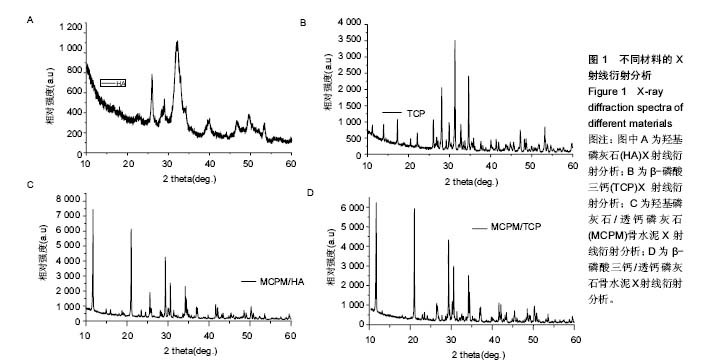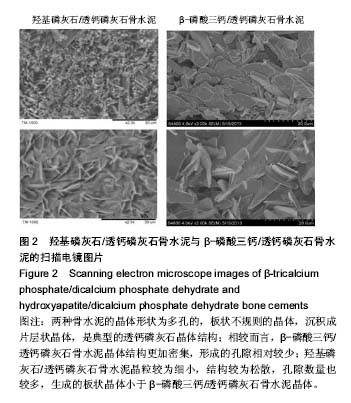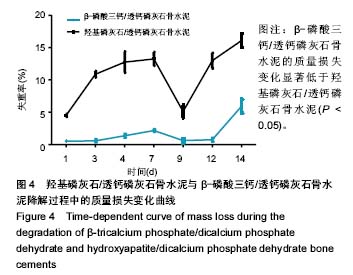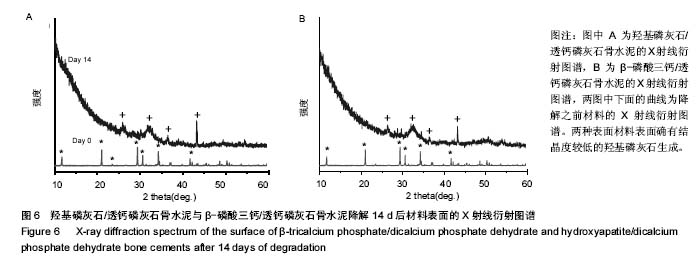中国组织工程研究 ›› 2018, Vol. 22 ›› Issue (6): 821-826.doi: 10.3969/j.issn.2095-4344.0053
• 组织工程骨及软骨材料 tissue-engineered bone and cartilage materials • 下一篇
羟基磷灰石体系透钙磷灰石骨水泥的理化性能
彭 磊,丁秀明,陈克伟,刘建莉,顾运涛,卞阳阳,孟珠龙,姚江陵,牟忠林
- 海南医学院第一附属医院创伤中心,海南省海口市 570100
Physicochemical properties of hydroxyapatite/dicalcium phosphate dehydrate bone cement
Peng Lei, Ding Xiu-ming, Chen Ke-wei, Liu Jian-li, Gu Yun-tao, Bian Yang-yang, Meng Zhu-long, Yao Jiang-ling, Mu Zhong-lin
- Trauma Center, First Affiliated Hospital of Hainan Medical University, Haikou 570100, Hainan Province, China
摘要:
文章快速阅读:
.jpg)
文题释义:
磷酸钙骨水泥:根据水化产物将其可分为透钙磷灰石骨水泥和磷灰石类骨水泥,透钙磷灰石骨水泥在生理环境下溶解度较高,并能促进新骨的生成;而磷灰石类骨水泥降解速度非常慢,一般被视为不可降解,故透钙磷灰石骨水泥受到更多的关注。
背景:传统的透钙磷灰石骨水泥是将β-磷酸三钙与一水磷酸二氢钙作为反应物,但将羟基磷灰石作为透钙磷灰石骨水泥反应前体的报道却很少。
目的:验证羟基磷灰石/一水磷酸二氢钙体系是否能够生成透钙磷灰石骨水泥,并分析其理化性能。
方法:采用湿化学沉淀法分别制备羟基磷灰石和β-磷酸三钙,再分别与一水磷酸二氢钙以适当比例均匀混合,加入适量固化液水,得到羟基磷灰石/透钙磷灰石骨水泥和β-磷酸三钙/透钙磷灰石骨水泥,应用X射线衍射分析两种材料的结构和组分,扫描电镜观察两种材料的表面形态,Instron 5567 型万能材料实验机测试两种材料的力学强度。将两种材料分别浸泡于模拟体液中,检测失重率;浸泡14 d后取出,再行X射线衍射和扫描电镜检测。
结果与结论:①X射线衍射分析证实,两种材料均为纯度较高的透钙磷灰石骨水泥;②扫描电镜显示,β-磷酸三钙/透钙磷灰石骨水泥晶体结构更加密集,形成的孔隙相对较少;羟基磷灰石/透钙磷灰石骨水泥的晶粒较为细小,结构较为松散,孔隙数量也较多,生成的板状晶体小于β-磷酸三钙/透钙磷灰石骨水泥晶体;③β-磷酸三钙/透钙磷灰石骨水泥的抗压强度高于羟基磷灰石/透钙磷灰石骨水泥(P < 0.05);④浸泡于模拟体液中后,β-磷酸三钙/透钙磷灰石骨水泥不同时间点的失重率均低于羟基磷灰石/透钙磷灰石骨水泥(P < 0.05);在模拟体液中浸泡14 d后,X射线衍射及扫描电镜证实,两种材料表面均有一层由球状颗粒堆簇而成的羟基磷灰石生成;⑤结果表明,羟基磷灰石/透钙磷灰石骨水泥具有良好的生物降解性能、生物活性及骨传导性,但力学性能较差。
中图分类号:






.jpg)